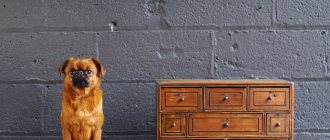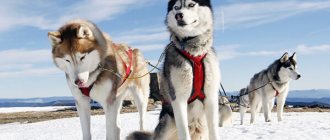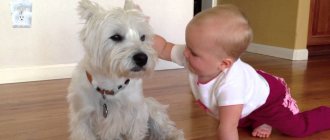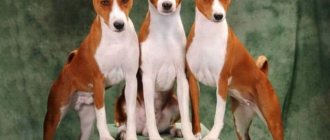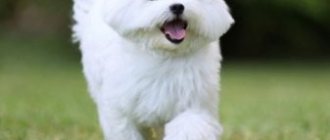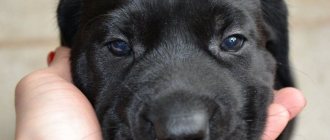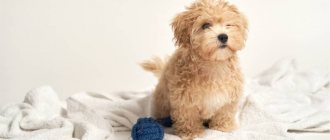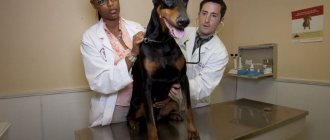Brussels Griffon, although it looks a little rustic, “rustic”, belongs to the decorative breeds of dogs; moreover, dogs of this particular breed have been the favorites of European monarchs for many centuries. They have a characteristic facial expression - impudent and arrogant, but this does not at all affect their character; they are devoted and loving pets.
There are three types of dogs - Griffons: Belgian, Brussels and Petit Brabançon, the birthplace of all these breeds is Belgium.
History of the breed
Dog handlers still have not agreed on which dog breeds became the ancestors of the Brussels Griffons. There is a version that the ancestors were rat-catching dogs that lived in poor Belgian neighborhoods and stables; they were used to catch rats. Perhaps the ancestors of these rat-catchers were Affenpinschers, Pugs and Ruby Spaniels. But another group of researchers is of the opinion that the ancestors of the breed were Irish and Yorkshire terriers.
It was thanks to the ability to catch mice that Griffons began to be found in royal castles, where they quickly gained popularity among aristocrats.
The breed first appeared at a canine exhibition at the end of the 19th century, and soon received official recognition. From that moment on, Griffons gained popularity outside of Europe, especially in the USA.
As a result of two world wars, the dog population in Belgium decreased significantly; new dogs began to be imported from England and the USA. Thanks to the fruitful work of dog handlers, a breed standard was developed and adopted in 1998 and 2003.
People often ask how to spell the name of the breed. So, the correct name is Brussels Griffon, not Griffon!
Character
Griffons, despite their decorative appearance, were originally rat-catching dogs - the ancestors of the breed were agile and agile small dogs that lived near stables and whose task was to catch rats. To this day, the breed has not lost its passion and working qualities.
Breeder's observations: Griffon can hardly be called a monogamous breed. He loves all people together, makes contact with strangers very easily, moves to a new home, and stays for foster care without any problems. Thanks to this, griffons adapt well to new environments.
Left alone, griffons tend to sleep soundly, in this respect they resemble cats. But if they get bored, like any dog, they can become involved in sabotage during puppyhood. Therefore, it is worth providing your pet with a variety of toys.
Griffons are very smart. They quickly learn the rules of living in the house, the habits of the owners and adapt remarkably well to them, demonstrating their best qualities. Thanks to this, they are able to quickly win the hearts of every family member. The breed is very sociable and needs constant contact with its owners.
Griffons are thinking dogs, humanly intelligent. They assess the situation and plan their actions several steps ahead. Males are more straightforward, “girls” are more cunning. These kids will not miss out on their benefits.
Griffons get along well with other animals, including cats and parrots. However, some individuals can hunt birds or small animals. The hunting instinct in them is still well developed. But if the puppy grows up in a house with other animals, there are no problems.
The Griffon is peaceful, but if it gets into a fight with another dog, it will not yield.
Griffons get along well with children and play happily with them.
Breeder's observations: Representatives of the breed are almost impossible to piss off. They are not touchy or vindictive.
Aggression or cowardice are not typical of griffons. Manifestations of these qualities are a marriage.
Griffons are clean dogs, but the degree to which this quality is expressed depends on individual characteristics. There are dogs who would never agree to get their paws wet in a puddle, while others are ready to run happily through the mud.
Some griffons snore in their sleep, and sometimes the volume of their roulades can rival that of longshoremen.
In their youth, griffons are very active, ready to rush from morning to evening. With age they become calmer and more reasonable.
Griffons tolerate the road well and usually sleep on the way. The main thing is to protect them from overheating at extremely high temperatures or from hypothermia at low temperatures.
Griffons are emotional and do not hide their feelings. They have very expressive facial expressions; literally all the nuances of their mood are reflected on their faces.
However, do not forget that each dog has its own character. Moreover, the griffon, which is the only pet in the family, behaves completely differently from griffons that live in a “pack”.
Description of the breed
Brussels Griffons are compact, slightly square-bodied dogs, and they also have a large head, especially in relation to the body.
The length of the body from the shoulder-scapular joints to the ischial tuberosities should be equal to the height of the dog at the withers.
None of the breed standards stipulate the height of the dog. As a rule, it is 25–36 cm in males, 23–32 cm in females, and the weight varies from 2.5 to 6 kg.
Griffons have a wide, rounded skull, the transition from the forehead to the muzzle is very clearly defined. The muzzle is quite short, according to the standard no more than 15 mm.
The Griffon's tightly closed lips are adjacent to the jaw, and the upper lip does not sag and does not overlap the lower one; there should be no jowls. They have a pronounced undershot, the lower wide jaw is curved upward and protrudes noticeably beyond the upper. The incisors on both jaws are located in one line. If the dog's mouth is closed, then the teeth should not be visible.
Dogs have a jet-black nose, the nostrils are wide and open. If you look at the dog from the side, you can clearly see that the nose, forehead and chin are located in the same plane. On the small muzzle, large round eyes with tight-fitting eyelids, brown in color, stand out as a dark spot, and the darker they are, the better.
Griffons have small, neat ears that are set wide apart. In some countries they are cropped, and the ears become erect and pointed; if this does not happen, then they remain semi-erect and droop forward.
The neck is not long, flowing smoothly into a short back with a slightly arched loin with good muscles. The chest is quite wide and deep, the ribs are curved. The stomach is tucked.
The tail is set high, it can either be docked at 75% of the length or left at its natural length; the Brussels Griffon wears this tail raised up, without curling it into a donut.
The fore and hind legs are widely spaced and parallel to each other, the muscles are well developed. Elbows should point straight back and not be turned out.
The hock joints are low and not turned out. The paws are small and compact, with the toes neatly gathered into a ball, the pads are dense and elastic, the claws are dark. It is desirable that there are no profitable fingers.
Coat
The coat of this type of Griffon is hard and thick, with a slight wave and undercoat. The coat is of medium length, so the dog’s silhouette is not hidden, but on the face, especially near the eyes and nose, the hair is elongated, and there is an extravagant beard on the chin and “eyebrows” above the eyes.
In color, only red is allowed, the only exception is a little black on the mustache and beard. The color of the coat can be of different intensities, but preference is always given to the brighter color.
According to some publications, it belongs to the short-haired breeds, although this is a very controversial point. In our opinion, it should be classified as a medium-haired breed, like its brother, the Belgian Griffon.
Possible disadvantages
Any discrepancies with the standard are considered deficiencies. Thus, disqualifying defects for the breed are:
- dentition disorders;
- nose color is not black;
- the tail is broken or curled;
- a tongue protrudes from a closed mouth;
- the lower jaw is distorted;
- any color other than black, or spots of a different color on the body.
In Brussels Griffon males, the testes should be completely descended into the scrotum.
Brief historical background
There are several versions of the origin of griffins. According to one of them, the ancestors of these small funny dogs were dogs called smousje, who lived in peasant farms in the vicinity of Brussels several centuries ago (14-15 centuries) and were engaged in the extermination of rodents (rats and mice), which were found in abundance in barns and granaries. The animals had a narrow, long muzzle, which helped them cope with their responsibilities better. The infusion of pug blood made them more miniature and aristocratic.
Some researchers believe that the Brussels was the result of deliberate crossing of Affen Pinschers with spaniels or wild Belgian dogs. Others believe that, on the contrary, German pinschers descended from the ancient griffons. There is an opinion suggesting the presence of an admixture of Yorkshire and Irish terrier blood. One way or another, cynologists came to an agreement in determining the exact date of the breed’s origin, believing that it appeared no later than the 30s of the 15th century. Some small dogs, extremely similar to modern Brussels griffins, were depicted on their canvases by painters of that time (Jan Van Dyck “The Arnolfini Couple”, 1434).
Artists often depicted dogs that looked like griffins in their canvases.
The breed became wildly popular among the nobility; even royalty (the Belgian Queen Marie-Henriette) bred it and kept it as pets. Court ladies and aristocrats almost never parted with their dogs and carried them with them everywhere.
The first official appearance of griffons occurred in 1880 at the Brussels dog show, but they were called a little differently - the small Belgian wire-haired terrier. In 1904, the first breed standard was written and approved, which was finalized and supplemented in 1963. The latest valid version of the standard dates back to May 5, 2003, in the FCI registry Brussels Griffons are listed under No. 80 in Group 9 (Companion and Toy Dogs), Section 3 (Small Belgian Dogs).
Brussels Griffons came to our country at the very end of the 20th century; in 1993, a couple of dogs were brought from the USA.
Interesting photo
Prices for puppies and adult dogs
To purchase a real Brussels Griffon, it is best to contact a nursery. Don’t be afraid of the relatively high price for a puppy, since from the moment of purchase a loyal, reliable, and most importantly quite predictable friend will appear in the family. In a specialized nursery, a puppy will cost from 250 to 600 US dollars. From an ordinary, private breeder, the price is strikingly lower - 100-150 US dollars. However, if you buy a dog outside of a kennel, you cannot be completely sure of the purebred of the puppy.
If the breeder decides to purchase an adult dog, then the price will be slightly higher, since its cost depends on the working properties of the dog and ratings in competitions. Thus, the most expensive dog will be an adult dog of the highest competition and exhibition level, properly trained and absolutely healthy.
How to choose the right puppy
The offspring of the Belgian Griffon are not cheap, which means you should not immediately run to the first ad you come across for the sale of purebred puppies. As a rule, you can only purchase a healthy and high-quality representative of the breed from professional breeders. It is necessary to carefully study the offers of breeding nurseries, familiarize yourself with the puppy’s pedigree and only then purchase a dog. The best option would be to visit a dog show and personally communicate with the griffons. Only in this case can you understand whether such a dog is suitable for a particular person.
The prices for Belgian Griffon puppies are not low, but in order to purchase a completely healthy dog, you need to prepare a certain amount of money.
Before you buy a puppy, you need to decide what your goal will be in purchasing this breed? If you want to get just a faithful friend for your family and an active companion for joint walks, you should opt for the Avito website. Many breeders there offer to buy a purebred griffon puppy for quite reasonable money. The price on the website is $190-350.
To participate in exhibitions and further breed Belgian dogs, it is better to purchase puppies from elite nurseries. Prices for such four-legged friends rise several times, and range from $650 per puppy , but the buyer will be confident in the purebred of his pet.
You should not purchase griffon babies from sellers who ask for a nominal fee for the dog. Most likely the puppies are not purebred. In addition, experienced breeders will not breed a dog if it has any diseases along the pedigree line, otherwise the offspring will be born defective. Breeders who make a business out of selling cheap puppies will most likely hand off a not entirely healthy and purebred animal to the new owner. Many buyers who fell for the low price regret their purchase for a long time, continually shelling out money for long-term and sometimes completely useless treatment for their pets.
You need to buy a puppy only after the animal is 3 months old; it is before this period that the dog undergoes the necessary vaccination and deworming procedures. When choosing a four-legged companion, you should pay attention to the following nuances:
- Dogs' eyes should not have crusts or smudges;
- the animals' heads are large and round in shape;
- the stomach is elastic, but does not protrude to the sides;
- the coat is shiny, bright, and fits tightly to the body;
- the mouth is clean, the teeth are straight;
- The dogs' movements are smooth, their gait is confident;
- The puppy is not intimidated, but does not show signs of aggression.
When purchasing a puppy, you should carefully check all the data indicated in the veterinary passport (dates of vaccinations, deworming, treatment for parasites). In addition, it is encouraged to constantly maintain contact with the breeder, who, if problems arise in raising or caring for the griffon, will tell the new owner the best way to solve it.
Pros and cons of Griffon
Like any dog breed, the Brussels Griffon has both weaknesses and strengths. The advantages of the breed are:
- healthy gastrointestinal organs;
- endurance;
- innate balance and goodwill;
- activity;
- fearlessness;
- the dog is hypoallergenic;
- desire to learn.
The pitfalls of the breed include the following factors:
- great natural selection in the first days after birth;
- predisposition to various eye diseases;
- difficult birth.
Thus, the disadvantages are the physiological characteristics of the breed, but only good things can be said about the character of this breed.
Brussels Griffon price
A Brussels Griffon with elite origin and good health will cost the future owner 40,000 rubles.
The price can vary in any direction, based on several factors: the location and popularity of the kennel, the age and gender of the dog, titles and awards of its parents. For a lower cost – about 15,000 rubles – you can buy a “Brussels” from your own hands, but in this case no one guarantees the health and good immunity of the dog. No matter how much you have to pay for a griffon, it's nothing compared to what a loyal and cheerful friend you'll get! A representative of this breed will bring some fun to even the most monotonous everyday life.
Features of care and maintenance
Properly caring for such a pet will not be difficult. Since these dogs have coarse hair structure, they require special care.
Griffons cannot be cut. To rid your pet of dead hair, you need to trim it: a small amount of hair is pinched between two fingers and smoothly pulled in the direction of hair growth, as a result, dead hairs remain between the fingers. This procedure is quite long-term, but a professional can handle it faster, so it’s better to contact a groomer.
Griffons love water treatments, so they will happily bathe once every 6-8 days; to wash them, you should purchase a specialized dog shampoo.
The dog must be combed daily with special combs or a glove, and this is especially effective during the animal’s molting season. The dog's face needs special care. The first step is to carefully trim, and after that, too long hairs can be carefully trimmed with scissors. After every walk and meal, the folds on the face should be wiped, this will help avoid many infections.
Claws need to be trimmed once every two months, preferably after bathing; a nail clipper will help with this. The dog's eyes also need to be carefully looked after - if they begin to sour, they must be wiped with a cotton swab dipped in a decoction of chamomile or strong black tea.
The griffon needs to brush its teeth weekly; special brushes and toothpastes for dogs are used for this.
Do not forget about antiparasitic therapy - every month the dog must be treated for fleas and ticks and once a quarter for helminths; products for such procedures can be purchased at a veterinary pharmacy.
Grooming
The griffon's molting occurs almost unnoticed by its owners, and this is very convenient. This breed very rarely causes a reaction in people who are allergic to dog hair.
- To keep the coat looking beautiful, dead pieces of fur need regular plucking . When this procedure is carried out correctly, the dog does not suffer any pain, so the animal tolerates the procedure calmly, without showing negative emotions.
- After this, the wool becomes much softer and more pleasant to the touch. This is a long and painstaking work, so it is best to go to a professional grooming salon, where this manipulation will take no more than an hour and a half.
- The muzzle is trimmed to make the dog look beautiful and neat . When grooming, you should be especially careful in the eye area so as not to accidentally cause serious injury to the animal.
- It is advisable to use a special glove for grooming; when using it, the animal sheds much less. It is necessary to regularly clean the characteristic folds on the muzzle, otherwise inflammation or dermatitis may occur under the folds.
- The coat should be brushed regularly with a hard brush with short bristles, in the direction of its growth. You need to comb it at least twice a week.
- After each walk, the animal's paws are washed. Pets are bathed very rarely: the less frequently, the better. They do not tolerate washing well and get cold easily, so you should only rinse the animal in the shower if it is very dirty. When washing, shampoos and anti-parasitic agents for decorative dogs are used.
Diet
Immediately after purchasing a puppy or adult Griffon, you should discuss its diet with a veterinarian or specialist who is familiar with this breed. They can be fed either with ready-made dry food, choosing only premium food, or with natural products - the choice is yours. If the owner decides to choose dry food, then it is important to follow the instructions and not give more food than the manufacturer recommends.
Dogs that eat dry food need plenty of drinking water.
If the choice fell on natural products, then it is advisable that the dog eats freshly prepared food and only from the right products. The dog's diet should include:
- Meat can also be given raw, but only if the breeder is confident in its high quality, it can be chicken, beef, rabbit, turkey;
- Boiled sea fish, boned;
- Cereal porridges – buckwheat, oatmeal, rice;
- Vegetables and fruits, both raw and after heat treatment;
- Lactic acid products, preferably with low fat content;
- Eggs, but no more than one per week;
- Butter and sunflower oil – 5-10 grams per day.
Feeding your dog table scraps is strictly prohibited.
Also extremely undesirable:
- spices;
- smoked and pickled food;
- confectionery;
- tubular bones.
The dog should not overeat, this can lead to serious obesity. A puppy should be fed 4 times a day, and an adult dog twice a day, at the same time.
Where to buy a Belgian pet
The Griffon is a fairly expensive pet, so you need to be especially careful when buying it. Today, there are a lot of advertisements on the Internet that offer to purchase a purebred Belgian. But unfortunately, many of them are just money scams. To avoid becoming a victim of scammers, it is recommended to follow some simple rules:
- buy puppies only from trusted sellers;
- before buying a pet, visit canine exhibitions and consult with specialists;
- buy a pet over three months of age, when it has received all the necessary vaccinations and deworming;
- check the puppy’s passport, medical certificate, and pedigree;
- pay attention to appearance - the puppy must be well-groomed, active and healthy.
It is preferable to buy Belgian Griffon puppies from trusted breeders.
The cost of a griffon varies depending on its natural characteristics and the seller. Naturally, it is much cheaper to buy a pet from your own hands than from a nursery. So, its cost varies between 8,000–50,000 Russian rubles. Show dogs are the most expensive.
List of the most popular nurseries:
- “Attack of the Griffons”, Moscow;
- “Griffon Cattery IGELS”, Obninsk;
- "Maryland", Moscow;
- Russian Symphony, Moscow.
Health
Brussels Griffons are not particularly healthy; their life expectancy is 12-14 years. They have a predisposition to certain diseases. As a rule, pathologies of the organs of vision are especially common among them. Griffons are susceptible to the following diseases:
- cataract;
- narrowing of the nostrils;
- eyelash growth;
- retinal atrophy;
- prolapse of the eyeball;
- hydrocephalus.
Another feature of the breed is difficult childbirth, often ending in caesarean section.
Diseases characteristic of griffons
Brussels residents have a fairly strong immune system and rarely get colds. But this breed can suffer from the following pathologies:
- Difficult birth. Many small females are unable to deliver their babies on their own and have to resort to caesarean section.
- Eye diseases: Loss of eyeballs (the eye bulges, swells and turns red). It is dangerous due to visual impairment and even loss of an eye; treatment is surgical.
- Irregular growth of eyelashes (distichiasis). Hairs grow on the inside of the eyelids, causing corneal ulcers. Only excision of hair follicles helps.
- Cataract (clouding of the lens). Risks of blindness. Treatment is surgical.
Griffons live from 12 to 14 years, but there are also long-livers who have crossed the 16-year mark.
Reviews about the breed
Once you see the baby Brussels Griffon, you won’t be able to remain indifferent. Here are some reviews about the breed. The authors' style and punctuation have been preserved.
Julia
Our little griffon is a very kind and affectionate dog, everyone loves him. He quickly found a common language with all family members and became a loyal friend to his three-year-old daughter. Captures the mood from a glance and never gets in the way. They don't shed at all - there is no wool in the house. True, there is a minus - he likes to fool around and play with soft toys.
Andrey
We decided to get two griffons at once - Mickey and Mouse. Very funny and intelligent creatures. They got used to the toilet in just a couple of days, they don’t chew things and furniture. They quickly learned the basic commands and are happy to carry them out on walks. We are already hoping for offspring soon.
Elena
This is not a dog, but a real positive! Smart, kind and affectionate. He quickly became friends with a five-year-old cat, and now they even sleep together.
Education and training
Raising and training a puppy must begin from the moment it appears in the house. The Belgian Griffon, although a wayward dog, is easy to train and listens to its owner’s commands with pleasure. During the training process, it is necessary to adhere to three basic principles:
- regularity;
- softness;
- encouragement
The Belgian pet can easily master both basic commands such as “sit”, “voice”, “lie down”, and also complete agility (a sport in which pets and their owners participate) without any problems.
Belgian Griffons are easy to train and educate.
